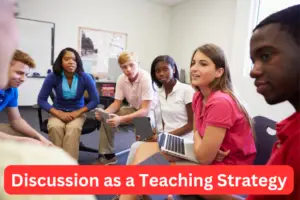Are you a teacher and you are in search of a teaching strategy to adapt? Discussion strategy may work just perfectly.

Introduction
Teaching, to some, is very stressful, while others who are trained and are aware of various teaching methods and strategies, find teaching interesting because they are very much aware of strategies to use at different times. For the purpose of this article, we will be focused on discussion as a teaching strategy.
As an individual who gets involved in discussions on a daily basis, you are probably conversant with what it entails. Discussion involves the exchange of ideas on a given subject, between a group of people. Hence, discussion as a teaching strategy is a powerful and versatile method employed by educators to facilitate learning in various educational settings, from classrooms to online platforms. It involves engaging students in open conversations, debates, or group exchanges of ideas, often focusing on a specific topic. Discussions can take many forms, such as seminars or small-group dialogues. This teaching strategy is widely used for its ability to promote active learning, critical thinking, and effective communication skills among students but despite these positive impacts on students, not all teachers use this method because it involves a lot of planning, from the preparation of the content of discussion to class settings. The preparation process can be time consuming.
Advantages of Discussion as a Teaching Strategy
Like other teaching methods, discussion strategy has both its pros and cons. Considering the advantages, below are some advantages of the discussion as a teaching strategy:
1. Promotes Active Learning

Discussions require students to actively participate, analyze information, and express their ideas. This engagement fosters a deeper understanding of the subject matter. When students are actively involved in the learning process, they are more likely to retain and apply the knowledge. So, if your goal as an educator is to get all your students to participate in the classroom. This is a sure way of learning.
2. Enhances Critical Thinking:
During the course of discussion, students are encouraged to think critically and analyze information from multiple perspectives. They learn to question, evaluate, and refine their ideas, which is crucial in developing their critical thinking skills. In other words, discussion as a teaching strategy trains students in reflective and critical thinking, leading to deeper understanding of the subject matter under discussion.
3. Encourages Collaboration

Group discussions encourage collaboration and teamwork.
This is so because when students engage in discussion, there is room to agree and also share different views with others. This helps them learn to tolerate the views of others even if they are unpleasant and contradictory to each other. Thus, respect for the viewpoints of others is developed.
On the other hand, students also learn to work together and constructively critique one another’s ideas. These skills are valuable not only in education but also in real-world scenarios.
4. Develops Communication Skills
Back in my school days, this method of teaching helped me to learn very effectively. Aside from the fact that having other students share their ideas was the easiest way for me to understand certain topics, engaging in discussions helped me work on my communication skills. It also gave me a certain level of confidence to face my fellow students. So, if you’re still contemplating on the need to incorporate discussions into your teaching strategies as a teacher, understand that engaging in discussions hones communication skills, including active listening, articulation, and the ability to express ideas clearly without panicking. Effective communication is a fundamental life skill that students can carry into their future careers.
5. Fosters Confidence
Like I mentioned above, the discussion method of teaching helped me to build some level of confidence. As students actively participate in discussions and receive feedback, their confidence grows. They become more comfortable expressing their opinions and engaging in intellectual discourse, which can boost their self-esteem. Thus, if you desire to raise confident students, include the discussion method of teaching in your strategies.
6. Encourages Inclusivity
Discussion, as a teaching strategy can be adapted to accommodate various learning styles in order to make education more inclusive. Oftentimes, introverted students who may not participate as readily in traditional lectures often find a voice in this teaching method.
Disadvantages of Discussion as a teaching strategy
While discussion as a teaching strategy offers numerous advantages, it’s important to acknowledge its potential disadvantages and challenges too. So, here are the disadvantages of discussion method of teaching:
1. Uneven Participation
In some discussions, a few students may dominate the conversation, while others remain passive or silent. This can result in an inequitable distribution of learning opportunities. This sometimes might breed disunity if not well managed. So, one important disadvantage of this teaching strategy is that some students may not take part while others may try to dominate.
2. Time-Consuming
Effective discussions often require more time than other traditional teachings or presentations. Planning, facilitating, and debriefing discussions can be time-intensive for educators.
3. Difficulty Managing Large Classes

In larger classes, managing a discussion can be challenging. It may be difficult to ensure that all students have the opportunity to participate and contribute meaningfully.
4. Disruptive Behaviour
In some cases, students may engage in disruptive or unproductive behaviour during discussions, such as talking off-topic, interrupting others, or dominating the conversation to the detriment of others. Some teachers may not want this, hence the reason for not using this method of teaching.
5. Potential for Misinformation
If students are not guided effectively, discussions can sometimes lead to the spread of misinformation or misconceptions.
This was the case in one of our biology classes in my Secondary School days. Apparently, the topic for that day was about reproduction and unusually, the teacher made it a discussion class. He probably wanted to know how much we knew about the topic.
While it was fun as some students were shy to contribute, it appeared that many students had wrong information about sexual reproduction. Thankfully, we found out because of the method of teaching used and the misconceptions were corrected by the teacher who hilariously ended his class with, “That’s how you girls would have gone to carry unwanted pregnancy” because of wrong information.
6. Limited Coverage
Besides the fact that teachers may find it difficult to cover a broad range of topics or material within a limited timeframe when discussions are time-consuming, Discussion as a teaching strategy is not a perfect method of teaching for all topics.
While these disadvantages are important to consider, they can often be mitigated through effective pedagogical strategies and classroom management techniques. Discussions, when properly structured and facilitated, can remain a highly effective teaching strategy that addresses many of these challenges.
Tips for Effective Use of Discussion Strategy
The essence of discussion is dialogue and the expression and exchange of ideas, opinions and knowledge. Irrespective of this, the outcome of this teaching strategy may not be as effective as other teaching methods. Because discussion can be an unpredictable method and the outcomes uncertain, many teachers avoid it.
However, this does not apply to every educator. For the teachers who may be willing to us the discussion teaching strategy, there is always a way to use this method of teaching effectively, and below a tips and guides to achieve that:
1. Create clear guidelines for the class discussions
These guidelines might specify how many times a student may or should contribute. While these guidelines may help you manage the noise in your classroom, they may also produce a more rigid environment in which students are less willing to speak freely.
2. Lead the discussion but don’t dominate
As a teacher, you will sometimes lead the discussion in order to keep things under control and to keep the discussion focused on the main points. However, you shouldn’t dominate discussion or impose your ideas and opinions on the students.
3. Get everyone involved in the Discussion
Make sure everyone is involved, and willing to be involved, in the discussion. I have observed a number of sessions in which teachers are really enjoying an in-depth discussion with a few like-minded students about an item of mutual interest whilst the majority of the group are showing clear signs of boredom.
4 Know when to end a discussion
Don’t let a discussion linger. When it’s obvious that it has reached the end and no meaningful contributions are forthcoming, bring it to an end but don’t forget to summarize the key points and relate them to the topic.
Conclusion
Incorporating discussion as a teaching strategy offers numerous benefits to both educators and students. It goes beyond the mere transmission of information and engages learners in a dynamic and participatory learning process. This approach equips students with critical thinking skills, effective communication abilities, and the confidence to engage with diverse ideas, ultimately preparing them for success in their academic journeys and future careers. While it requires thoughtful planning and facilitation, the advantages of discussion as a teaching strategy make it a valuable tool for promoting meaningful and lasting learning experiences.
References
Chourasiya, S. (2022, June 17). Discussion method of teaching. Samar Education. https://www.samareducation.com/2022/06/discussion-method-of-teaching.html?m=1
Don’t miss out on current updates, kindly like us on Facebook & follow us on Follow @EAfinder OR leave a comment below for further inquiries






